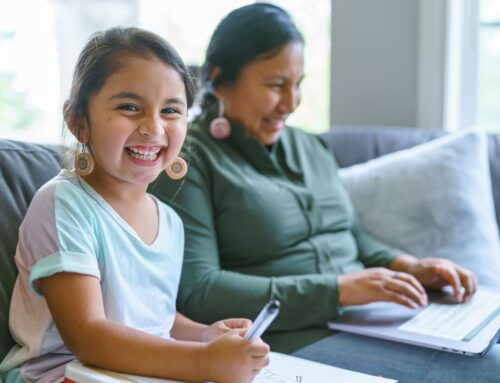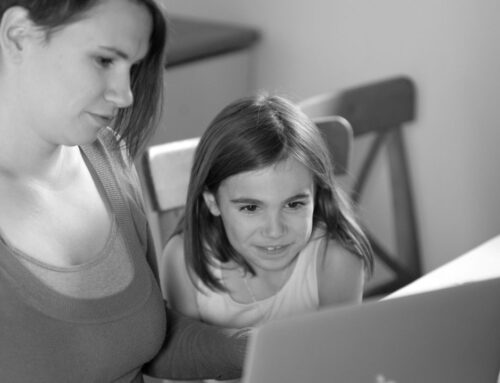Families enrol their children at SelfDesign for many different reasons. In some cases, the public education system may not be working out for the child or the family. In other cases, the child may have developmental issues not adequately addressed in a local public system. Sometimes, the family may want to try a different path that emphasizes different traditions or values, or they need flexibility to travel or to pursue sports, music or other interests. It may even be that, for families living in remote areas, the commute to school is just too long.
Whatever the reason they choose SelfDesign, parents may find their families and friends question that decision.
Even SelfDesign’s Principal of Educational Programs Nikki Kenyon has faced this.
“As a home-learning parent, I come up against this regularly,” she says. In addition to her leadership role at SelfDesign, Nikki has worked as a learning consultant with SelfDesign Learning Community and is the parent of four children who have been enrolled in the kindergarten to grade 12 program.
She says comments from family members can trigger her own insecurities about doing the best for her children, even when she has seen how SelfDesign’s approach to learning can help young people and families thrive.
Over the last 17 years, SelfDesign Learning Consultant Jennifer Engracio has worked with hundreds of families with children enrolled in kindergarten to grade 9 with SelfDesign Learning Community. The B.C. certified educator says almost every parent she has worked with has experienced resistance to their decision to join SelfDesign from family members.
“It’s part of living a life that goes against the mainstream norm,” Jennifer says. “It’s normal, and I tell people to expect it.”
But, she says, it also is possible to lessen the impacts of such resistance on learners, parents, and the parent–learner relationship. Furthermore, a family’s SelfDesign learning consultant is there to help support the parent through that process.
Here, Jennifer shares eight tips to help parents deal with resistance to their and their child’s chosen learning path:
1. Ground yourself in the values that brought you to SelfDesign
Connect to the values and reasons that brought you to SelfDesign in the first place.
My job as a learning consultant is to support the family to really hone in on why they chose SelfDesign – why they chose self-directed learning for their child or why their child chose self-directed learning for themselves. I support the family to stay connected to their own values, so that even in the face of opposition from family or others, they stand strong on why they made the decision – so that the outside world’s opinions don’t matter so much.
2. Set boundaries, then work to maintain them
Most of the time, it’s about setting boundaries with extended family and just saying, “This is just something we’re likely not going to agree on.” And then making sure the boundaries are maintained.
It can be hard to do this, but it’s also the place where the most growth can happen. Every time a family upholds its boundaries, those core values are strengthened.
3. Focus on supporting the child, not converting reluctant family members
I don’t recommend that parents try to convert anybody in their family. That takes way too much energy. That’s energy you could be putting into supporting your children in their self-directed learning.
4. Give your children the tools to respond to questions
Families can do things to try to prepare their children so they don’t get stuck in weird situations. For example, teach your children what to say if auntie or grandma or grandpa starts to ask questions about home learning that make the children uncomfortable. It can be a script like, “This makes me feel uncomfortable,” or even “My mom said to talk to her about this.”
5. Invite family members to engage with and learn about SelfDesign’s approach
I often offer to talk to grandparents, aunties or uncles and answer their questions, if they’re open to it. I have invited family members to do an Observing for Learning session with me so that they can see what the process is like – what the engagement is like in this new way of working with the teacher. For most of them, the process and engagement is unfamiliar territory.
They can meet me and ask the question, “Are you a real teacher?” And I can answer, “Yes, I’m a real teacher.”
6. Share the Winter and Year-end Connections
SelfDesign’s Winter and Year-end Connections are basically a portfolio of the child’s learning and work through the year. If you have family who is resistant and you and your child feel comfortable, share the Connections with them. Let them know there’s a teacher guiding this process and tracking learning and all the BC Ministry of Education requirements.
7. Find a support network
I always encourage parents to reach out to each other and form their own mini-communities to share ideas and support each other. When you’re doing this on your own, it can feel pretty lonely, and it’s easy to feel isolated.
Join up with other families who are doing similar things and who you groove with, and talk about these things. Go for coffee, form a discussion group, trade tips with each other – because you’re all living this.
It could be with other SelfDesign families, but it doesn’t have to be. It may be other people who you meet on the local home-schooling list who have a similar philosophy as yours.
8. Stay true to your path
For many families, the longer they do self-directed learning with us and the more grounded they become in it, the more the extended family sees that the children are actually doing fine.
Auntie or grandma may never fully understand what SelfDesign is about, but I’ve worked with some families for over 10 years, and I’ve seen them go through the entire process with their extended families. Now that they’ve had a few children who have gone through the program and done well, the grandparents are like, “Okay. They’re fine. We don’t have to worry about them.”
Parents who enrol their children in SelfDesign Learning Community choose self-directed learning because they believe it is the best option for their children, but that decision may be questioned by other family members. The B.C. certified educators who work with SelfDesign parents and learners are there to help them stay true to their intentions and values and focus on supporting the learners.







